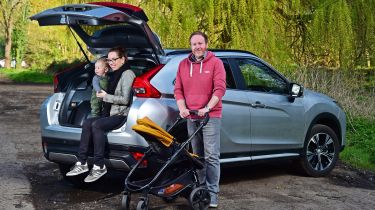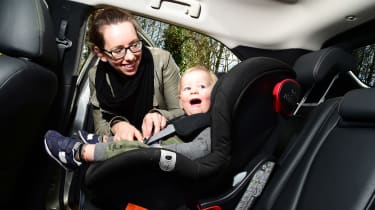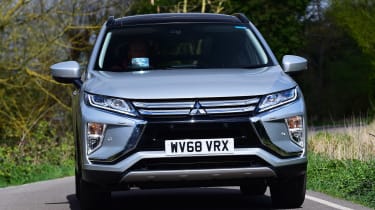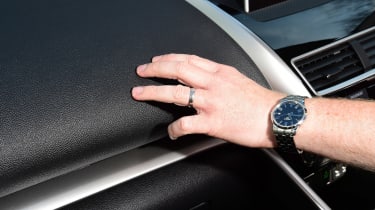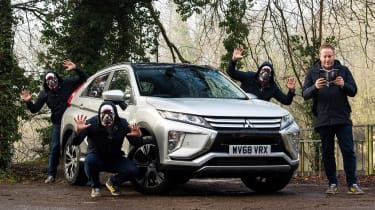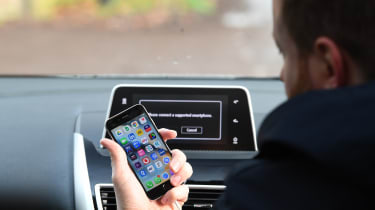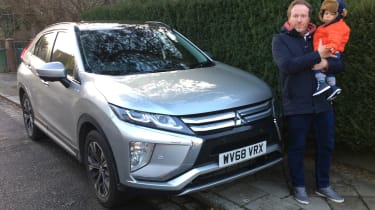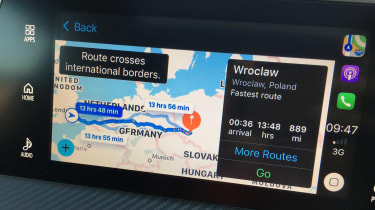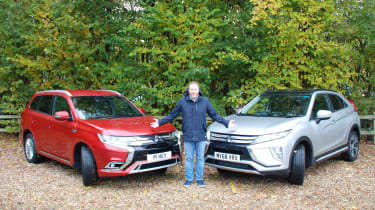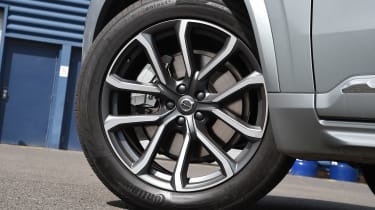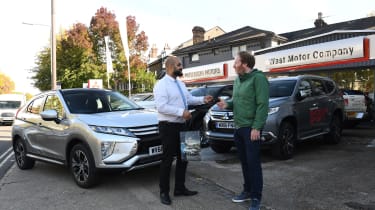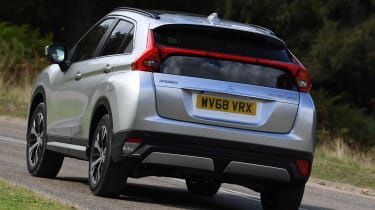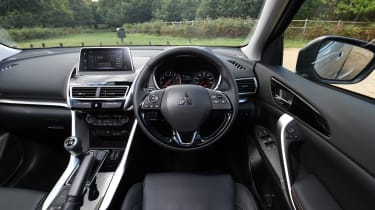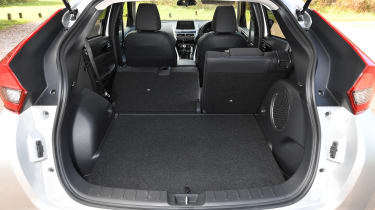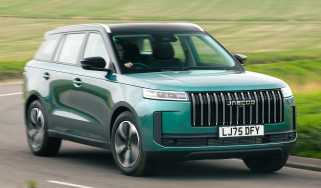Mitsubishi Eclipse Cross: long-term test review
Final report: rare Mitsubishi Eclipse Cross SUV is fine for families if you can live with its weaknesses

The Mitsubishi Eclipse Cross is far from perfect, with its rough ride and poor fuel economy holding it back in a very competitive class. However, it’s a capable family SUV with enough space for most people, while its rarity adds to the model’s appeal.
Mileage: 5,602Economy: 33.1mpg
It’s now the end of my time with the Mitsubishi Eclipse Cross, but one question still remains: why are there so few of them on UK roads?
Earlier this year Mitsubishi announced that the Eclipse Cross had passed the 80,000 global sales milestone, with more than 33,000 of those sold in Europe. However, during the six months that I’ve been running the car on our fleet, I can only remember seeing three other examples on the road – and one of those was a hire car.
• Best crossovers on sale right now
The limited number in my part of the UK is certainly not down to how it performs as a family SUV, though. When I took delivery of our top-spec ‘4’ car from Mitsubishi West London last September I was eager to find out how it would cope with the demands of day-to-day life, and I’m pleased to say it’s dealt with everything that we’ve thrown at it.
It’s provided six months of trouble-free motoring and that’s exactly what you want when you have a young family. The peace of mind you get from knowing that a car is reliable is invaluable, but that’s not where the Eclipse Cross’s merits end. I’ve been particularly pleased with the amount of interior space.
Used - available now

2023 Tesla
Model Y Premium
52,159 milesAutomaticElectric
Cash £22,697
2024 Honda
HR-V Hybrid
22,177 milesAutomaticPetrol1.5L
Cash £21,997
2024 Toyota
Yaris Cross
9,761 milesAutomaticPetrol1.5L
Cash £21,897
2024 Volkswagen
Golf GTE
25,554 milesAutomaticPetrol1.4L
Cash £21,176Getting my son in and out of his car seat in the back is a breeze and, despite my rather relaxed driving position, he’s unable to reach the driver’s seat with his feet to kick the back. This is helped by the fact that you can slide the rear seats back or forth to either create more legroom or extra boot space.
Speaking of the boot, although it’s not the biggest in its class, at 448 litres, it has more than enough space for our needs – even with the back seats in their rearmost position. We’ve got quite a big buggy, but the load bay comfortably swallows it and still leaves plenty of space for shopping bags or whatever else we have with us. The boot opening is also at a convenient height for lifting heavy items in and out, while the lip isn’t too obstructive, either.
Sadly, space is pretty much where the good news ends, though. The Eclipse Cross has plenty of negative points that could put prospective buyers off. The more time I’ve spent with the Mitsubishi, the more these points have started to bother me.
Let’s start with the way the car rides. It’s fine when cruising along the motorway, but family SUVs spend most of their time driving around towns and cities, usually heading on the school run or going back and forth from a supermarket. These, often very rough, roads really don’t suit the Eclipse Cross at all, because every single pothole or bump is felt throughout the cabin, while the whole car rolls only too obviously when cornering at anything other than low speeds.
I’ve also been a little disappointed with the quality of the interior. Even though ours is a top-of-the-range model, there are plenty of hard and unattractive plastics throughout and the piano black finish on the centre console looks like it could be easily scratched.
This all brings me back to the question of why there are so few of them on our roads. The negative points are sure to impact sales, but the average family SUV buyer probably isn’t going to put driving dynamics ahead of space and practicality. Why the Eclipse Cross is so rare is more likely down to the fact that it only comes with a 1.5-litre turbocharged petrol engine. Not only does this limit the choice, but it also means you’re stuck with some pretty disappointing fuel economy of just over 33mpg in our manual model.
There are no signs of the long-promised hybrid, despite Mitsubishi stating that model would follow soon after the car’s launch more than a year ago. In fact, the success of the larger Outlander PHEV suggests the Eclipse Cross would almost certainly be a bigger seller in the UK if it had a similar powertrain.
Finally, there is a host of talented rivals that the Eclipse Cross is up against. The crossover market is extremely competitive and it’s hard to recommend it when it comes up against the Skoda Karoq, Peugeot 3008, Renault Kadjar and many more. The Mitsubishi simply isn’t as good as many of its rivals. But it’s still a competent family SUV and, if you want to stand out from the crowd, its rarity could just be the reason to choose it.
Mitsubishi Eclipse Cross: fourth report
Four months with our Mitsubishi Eclipse Cross SUV reveal its Jekyll and Hyde characteristics
Mileage: 5,044Economy: 33.2mpg
I’ve now spent more than four months behind the wheel of our Mitsubishi Eclipse Cross, and I’ve come to realise it’s a car with a split personality. In fact, it reminds me of one of my favourite books: The Strange Case of Dr Jekyll and Mr Hyde, by Robert Louis Stevenson.
For those not familiar with the novel, it tells the story of the respectable Dr Henry Jekyll, who spends his life battling to control his evil alter ego Mr Edward Hyde. Although not quite as extreme, that’s how the Eclipse Cross behaves in day-to-day life. It’s often good one minute and bad the next.
• Mitsubishi Eclipse Cross vs Subaru XV vs Skoda Karoq
There’s much to like, but there seems to be an equal number of things to dislike. Quite often I can even go from loving a specific feature to hating it within the same journey.
Apple CarPlay is probably the best example of how one thing can cause so much frustration. Over Christmas, I drove to Poland and back, and used CarPlay for the whole trip. I updated my phone and added the Google Maps app in preparation, and it was flawless, navigating me to avoid the worst of the traffic and alerting me to any potential hold-ups ahead. I was also able to listen to a variety of podcasts to keep me entertained. It was definitely Dr Jekyll.
Yet just a few days after I arrived home, Mr Hyde appeared and CarPlay stopped working. I plugged in my phone, but… nothing. The car simply didn’t recognise the existence of my mobile. It eventually came to life after I’d stopped and started the SUV, but the same problem has occurred again since – often when I need it most.
No matter what could be responsible for the issue, this just highlights the fact that the Eclipse Cross doesn’t have sat-nav built-in. Our car is a high-spec ‘4’ and has plenty of kit, so you’d really expect navigation to come as standard, but Mitsubishi boldly decided not to offer it on any model in the range.
Having to rely on your smartphone without any form of a back-up option is sometimes a little alarming. I’m just happy the problem didn’t happen while I was on unfamiliar roads in Europe.
The load bay is another area that has its good and bad points. A family SUV should offer plenty of space, but the boot can only swallow 448 litres in its largest configuration, and that’s way down on key rivals like the Skoda Karoq (588 litres) and Peugeot 3008 (591 litres). You have to slide the rear seats forward to free up that space, and it’s still no match for the class leaders. It also slashes the amount of rear legroom.
Lift up the boot floor and there is extra storage available, though. Of course, you can only really access that space below if the rest of the boot is empty, but I have found it to be a really useful feature. It has proven particularly handy when transporting items that are fragile, because the compartments keep things in one place. No more broken eggs when heading back from the shop!
Even the styling of the Eclipse Cross reminds me of Dr Jekyll and Mr Hyde. I love the look of the front; here you can really see where Mitsubishi’s new ‘Dynamic Shield’ design language works, with the angular front bumper and slimmer headlights giving it an imposing presence on the road.
However, round the back, I feel it just looks awkward. To me it has a stubby appearance, with lots of harsh straight lines that do little to add to the Japanese model’s visual appeal. The long bar that splits the pane of glass looks out of place as well, and it certainly doesn’t help rear visibility, either.
Then there’s the ride. During the trip to Poland the Eclipse Cross performed admirably on the Continent’s smooth roads. It’s surprisingly comfortable on longer journeys, the seats offer good support and it’s easy to find a good driving position. But on anything other than flat tarmac, the car is shaken about like you’ve driven over something twice its actual size.
The gripes show that the Eclipse Cross is a long way from topping the crossover class, with many rivals offering more space, superior economy and better refinement. It’s an incredibly competitive sector, and Mitsubishi really needed to get every aspect right to stand a chance.
Mitsubishi Eclipse Cross: third report
How does the Mitsubishi Eclipse Cross SUV rate on a family trip to Poland?
Mileage: 4,478Economy: 33.1mpg
What is the ultimate test of a family car? For me, it’s the ability to travel long distances in relative comfort, while also swallowing a large amount of luggage. To see if our Mitsubishi Eclipse Cross fulfils that brief, I travelled more than 2,000 miles during the holidays to Wrocław, in south-west Poland, and back.
Getting there meant driving through France, Belgium, the Netherlands and Germany, before crossing into Poland. It’s a total journey time of almost 14 hours not counting stops, but the car performed well on the smooth Continental roads.
The 1.5-litre petrol engine has felt more than powerful enough during my time with the SUV, but I was wondering how it would fare on the Autobahn. I needn’t have worried because the Eclipse Cross easily coped with the higher speeds. While you do have to build up overtakes in advance, especially with cars often approaching at a rapid rate in the outside lane, it never really felt short on power. The seats were also comfortable throughout the trip.
Things weren’t so good driving around town itself, though. Wrocław is a fantastic city, but the roads come in all shapes and sizes. From cobbles to potholes, it’s not a smooth driving experience in any car, but was very unpleasant in the Mitsubishi. Rough terrain is its Achilles’ heel and each bump shook the cabin violently.
Economy remains an issue. I’d previously struggled to average more than 30mpg and things didn’t really change on the longer trip. Yes, the car was weighed down with plenty of luggage, but I expected more than 33mpg.
We heard from a reader whose ‘3’-spec Eclipse Cross has halogen bulbs, and he finds they fail to adequately light up the road. Our top-spec ‘4’ example comes with LEDs and they do a good job of showing the way.
Mitsubishi Eclipse Cross: second report
Thirsty engine counts against the Mitsubishi Eclipse Cross as we compare it to the larger Outlander PHEV
Mileage: 1,789Economy: 33.4mpg
Our Mitsubishi Eclipse Cross fulfils the family SUV brief in most departments: it’s proving to be practical, the seats are comfortable and it’s durable. But it also needs to be cheap to run and that’s where it falls behind some rivals.
I’m struggling to average much above 32mpg, which means plenty of trips to the pump and plenty of times I’ve had to open my wallet. Its main competitors in this sector all have low-powered petrol and economical diesel options for those who do a lot of miles.
The Eclipse Cross is limited in the fact that the 1.5-litre four-cylinder turbocharged petrol engine is currently the only power unit on offer. There are no diesel or hybrid options here.
To see what might have been, I’ve racked up a few miles in the larger Outlander PHEV, which has a 2.4-litre petrol engine and two electric motors. Being able to plug it in to charge and cruise around in EV mode meant I didn’t even have to fuel the PHEV in my time with it.
Given the Outlander PHEV’s enormous success, it seems strange that Mitsubishi hasn’t yet got an Eclipse Cross hybrid to market. I’m sure it would be a big hit if it could match the economy figures of its bigger brother.
Despite the economy woes, the engine excels in most other ways. Although the Eclipse Cross is a heavy SUV, the 161bhp output means it never really feels underpowered. It’s quiet and refined at lower revs, while offering decent punch, thanks to its 250Nm of torque. The manual box on our Eclipse Cross is also a much better fit than the CVT auto.
I’m planning a long trip across Europe this winter and am confident the Eclipse Cross will provide a comfortable journey. But my biggest concern remains just how often I’ll have to stop at the pumps to fill up.
Mitsubishi Eclipse Cross: first report
We get the keys to the mid-sized Mitsubishi Eclipse Cross crossover, and initial impressions are mixed
Mileage: 708Economy: 31.0mpg
Mitsubishi introduced the Eclipse Cross last year to plug a gap between the smaller ASX and larger Outlander, with the goal of stealing sales from some of the major players in the small SUV class. But this is one of the most competitive sectors out there, with a host of talented rivals, including the Skoda Karoq and Peugeot 3008.
So how does the newcomer stack up, and does it meet the needs of family life? I’ve taken delivery of a new Eclipse Cross to see how it performs as a family car, and with my son fast approaching his first birthday, the SUV is sure to be put to task over the coming months.
I picked up the keys from West London Mitsubishi in Barnes, and was shown around the car by sales executive Karrar Alsaidi. The Eclipse Cross is still quite rare on UK roads and seeing it in the metal I think it’s safe to describe the exterior design as a bit hit and miss.
At the rear, the horizontal bar that splits the two panes of glass and the panel line running down the side give it an ungainly appearance. However, the front is attractive and the LED daytime running lights add to its visual appeal.
Karrar guided me through the infotainment system and, although ours is a top-spec car, I was disappointed to hear that there’s no sat-nav. Apple CarPlay and Android Auto come as standard, so I’ll need to keep a cable in the cabin at all times and rely on Apple Maps instead. It is unusual for a car in this class not to feature sat-nav, and in fact it’s not even on the Eclipse Cross’s options list.
The large glass sunroof lets plenty of light in, making the interior feel larger and roomier than it actually is, while the nine-speaker Rockford Fosgate audio system is powerful and produces an even sound throughout the cabin. I’m also a fan of head-up displays and, while the set-up on our Mitsubishi is pretty basic, it does the job well.
I’ve only really had a chance to drive the Eclipse Cross around town so far, and initial impressions suggest it struggles to soak up bumps or potholes. The ride feels jittery on anything other than smooth tarmac. It’ll be interesting to see how it performs on longer journeys when I get out of London, where I live, and on to some motorways.
There’s currently only one engine option, a 1.5-litre four-cylinder petrol turbo with 161bhp and 250Nm of torque. It’s peppy and feels more than able to cope with the car’s 1,455kg bulk. Driving in town, the Mitsubishi never feels underpowered, and it definitely seems quicker than the quoted 0-62mph time of 10.3 seconds suggests.
When we’ve tested the Eclipse Cross in the past, we found the CVT auto box compromised the driving experience, so we’ve gone for the manual option instead. This version is not available with four wheel drive, but overall it’s a much better set-up. If only the gearstick were better positioned; it’s mounted to the left of the rather high handbrake, which is a little confusing and will take some getting used to.
Whenever I travel with my young son the car is usually packed to the rafters with a child seat, buggy, travel cot, changing bags and much, much more, so the Mitsubishi has to deliver here.
The flexible rear seat arrangement should help maximise the car’s potential because you can move the seats back or forth to increase load space or legroom for passengers in the rear. With the seats slid forwards, the boot is capable of swallowing 448 litres. While that’s not a class-leading capacity, it’s more than enough for me, for now.
And because we’ve gone for the top-spec ‘4’ model, I’m happy to report that our car comes with a level of safety tech that would please any family driver. The list includes lane departure warning, forward collision mitigation with auto braking and a reversing camera. The latter has already proven really useful when squeezing into a tight space.
*Insurance quote from AA (0800 107 0680) for a 42-year-old in Banbury, Oxon, with three points.

